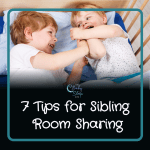 We’ve written before about room-sharing – what it is, how it affects sleep, and why it’s considered the safest sleeping arrangement for babies. Lots of us have probably shared a room with our babies at some point – during the newborn stage, maybe, when feedings were happening around the clock and we felt absolutely desperate for sleep!
We’ve written before about room-sharing – what it is, how it affects sleep, and why it’s considered the safest sleeping arrangement for babies. Lots of us have probably shared a room with our babies at some point – during the newborn stage, maybe, when feedings were happening around the clock and we felt absolutely desperate for sleep!
But while many parents choose to room-share, for one reason or another, plenty of other parents room-share out of necessity – there’s simply nowhere else for the baby to sleep! And while this room-sharing has some distinct benefits, this kind of living arrangement can make sleep training really, really tough.
So how do you work on sleep training while sharing a room with your baby? Read on and find out!
7 Tips for Sleep Training While Room-Sharing
If you have the option to move your baby out of your room during sleep training, know that doing so will probably make sleep training a little easier. However, we understand that not every family has that option; we also understand that not every family wants to stop room-sharing during sleep training.
If this describes you, don’t worry; while room-sharing can make sleep training a little more challenging, there are things you can do to make the process smoother for everyone:
- Consider moving out (temporarily!) If you’re in a ‘forced’ room-sharing situation, but you don’t mind sleeping away from your baby during sleep training, then consider moving out for a bit. This is especially helpful if your baby is older (9-12 months) or if you are sleep training a toddler. Try sleeping on an air mattress in another room of the house – such as the living room, for example. You could also move your baby out temporarily, as we mentioned earlier (provided you have the room to do so). But remember that during sleep training, you want to keep things as normal as possible for your baby. So if you expect to be sharing a room with your baby for a while, it might be best for you to move out for a week or two and to leave your baby in her usual environment.
 Move the crib or co-sleeper away from the bed. If your baby’s sleeping area is close to your bed, move it away. Having some distance between you and your baby will help in the sleep training process, especially if you use some kind of divider so that your baby cannot see you. (See the next point for details on using a divider.) Another great option is to use a product such as The SlumberPod® (Use Coupon Code BABYSLEEPSITE$20 for $20 off! Use this link if you’re in Canada!)
Move the crib or co-sleeper away from the bed. If your baby’s sleeping area is close to your bed, move it away. Having some distance between you and your baby will help in the sleep training process, especially if you use some kind of divider so that your baby cannot see you. (See the next point for details on using a divider.) Another great option is to use a product such as The SlumberPod® (Use Coupon Code BABYSLEEPSITE$20 for $20 off! Use this link if you’re in Canada!)- Stay out of sight. If your baby can see you (and let’s face it if you are room-sharing, then he can see you!), he will be much less inclined to fall asleep, and much more inclined to cry for you. You can solve this problem by creating a temporary divider between you and your baby. Shaye, one of our sleep consultants, hangs up a sheet when she travels with her daughter, which helps her little girl sleep better. You can also try draping a blanket over a collapsible coat rack in order to provide a quick (and temporary) barrier between parents and baby. Whatever you use, just be sure that your temporary barrier is placed well away from your baby, so that there’s no risk he could pull the sheet or blanket into his crib or bassinet.
- Use white noise (and possibly earplugs!). You don’t want to ignore your baby during sleep training, but sleep training may go a little easier if you do not hear every little noise your baby makes. And it will help your baby if he doesn’t hear every little noise you make, too! So, if you haven’t already, start utilizing white noise at bedtime. You can buy a sound machine; you can also download free or inexpensive white noise MP3s and apps. For more information about how white noise can help both you and your baby sleep, check out this past article. And for our recommendations about the best white noise machines and apps, take a look at this article. For even more noise-blocking, consider wearing a pair of earplugs at night. They really work!
- Stay consistent. We say this to every family we work with, whether they room-share or not. But, as you can imagine, consistency is even harder when your baby is sleeping (or not sleeping!) just a few feet away from you. However, consistency is the key ingredient in successful sleep training; that is just as true for families that room-share as it is for families that don’t.
- Stick with your sleep training plan for at least a week. Once you have your sleeping area set up (crib moved away from the bed, white noise machine/apps ready, the divider in place), implement your sleep training plan. But remember – do not expect results right away! Some babies respond quickly, but many need at least a week (maybe two) to adjust. If, after a week or two, your baby is showing no improvement at all, make changes to your sleep training plan. That may include changing your room-sharing situation, if necessary.
- Adjust your expectations. If you choose to/have to share a room with your baby during sleep training, understand that the process may take a bit longer. Even if you utilize all the tips listed above, sleep training may take longer (and feel more difficult) for you than it does for parents who sleep separately from their babies. This is okay, of course; it’s just important that you adjust your expectations going in. If your expectations are reasonable, then sleep training while room-sharing can work very, very well!









